Boxwood, Small-Leaved or Cape Box, Buig-my-nie, Afrikanse Buksboom, iGalagala, umGalagala, Umphicamaguma - Buxus macowanii
 Buxus macowaniiCondensed Version:
Buxus macowaniiCondensed Version:
Boxwoods are popular with gardeners for their attractive, compact, and low spreading growth habit, and are seen in almost any style of garden today. Their versatility is renowned and these plants can be pruned successfully into just about any shape you desire. Our indigenous boxwood is a small, very slow-growing tree with an upright habit, producing many stems with drooping branches and deep green leathery leaves, which give off a distinctive scent when wet or bruised. In the wild, once mature, it can reach +-9m tall with a 4m spread; with slender stems about 30cm in diameter, and a greenish bark that is roughish and grooved. In the garden, however, it is usually kept trimmed to +-25 to 70cm tall and 20 to 30cm wide.
Boxwood grows well in those regions of the country which receive good summer rainfall, both inland and at the coast. In dry regions regular watering is required to keep it looking its best. It is hardy to moderate frost, but very young plants should be protected in winter until they are established.
Boxwood will grow in full sun, but in very hot regions some shade would be appreciated. It even grows in almost total shade, but in these conditions growth will be less vigorous. Another great advantage is that the plant will also tolerate dry or wet shade, as long as the soil drains and is not boggy.
It is easy to cultivate in most fertile and well-drained garden soils. Prepare the planting holes well, adding copious amounts of organic matter like compost and a generous dressing of bone meal. Water regularly until the plants are well established.
Full Version:
Description, History & Interesting Facts:
Boxwoods are popular with gardeners for their attractive, compact, and low spreading growth habit. Their versatility is renowned and these garden plants can be pruned successfully into just about any shape you desire.
Buxus is a genus of about 70 species in the family Buxaceae, with members widely distributed throughout the temperate counties of the globe, excluding America and Australia. The Common Boxwood (Buxus sempervirens) and the English Boxwood (Buxus microphylla 'Faulkner') are quite well-known in South Africa, but did you know we have our very own Boxwood, which is just as versatile?
Our indigenous boxwood (Buxus macowanii) is endemic to South Africa, meaning that it grows wild nowhere else in the world. It can be found in the Eastern Cape, KwaZulu-Natal, Limpopo, Mpumalanga, and the North West Provinces. In coastal regions it grows in colonies in valleys and forests near the sea, and in coastal dunes, to medium altitudes.
It is a small, very slow-growing tree with an upright habit, producing many stems with drooping branches and deep green leathery leaves, which give off a distinctive scent when wet or bruised. In the wild, once mature, it can reach +-9m tall with a 4m spread; with slender stems about 30cm in diameter, and a greenish bark that is roughish and grooved.
In the garden, however, it is usually kept trimmed to +-25 to 70cm tall and 20 to 30cm wide. Insignificant male and female flowers are borne separately on the same tree from late winter to spring (July to October,) followed by brown capsules holding shiny black seeds, which ripen and split to release them. Although the flowers are inconspicuous, they are fragrant, and pollinated by insects and bees.
Uses:
The wood of this species resembles that of the European Box, with a beautiful yellow colour and a smooth texture. Even though it is hard with a fine grain, the early settlers used it mainly for firewood, but in the late 1800's it was exported to Europe, because of its popularity there for engraving. It was also in demand in the printing trade, as well as for musical instruments, furniture, implements, model making etc.
In the Garden:
Because boxwood responds so well to pruning, is slow growing, and has lovely small leaves, it is perfect for formal hedges and topiaries, parterres, knot gardens, and cloud pruning. And, although it is associated with traditional English box gardens, this is no longer the case, as boxwood has been modernised and is seen in almost any style of garden today.
In cold winter gardens the evergreen foliage provides welcome colour when everything else is a drab brown. Boxwood also provides a great backdrop for small flowering plants or bulbs, and if mass planted, makes a great groundcover for a formal grove of trees. It is also a valuable addition to woodland gardens, fantastic in containers, and a favourite with bonsai enthusiasts.
In the garden, boxwood is usually kept trimmed to +-25 to 70cm tall and 20 to 30cm wide; and nothing beats its lush green foliage for low hedging. Because it is slow growing, once established, boxwood is very low maintenance, requiring minimal clipping.
 Cultivation/Propagation:
Cultivation/Propagation:
Boxwood grows well in those regions of the country which receive good summer rainfall, both inland and at the coast. In dry regions regular watering is required to keep it looking its best. It is hardy to moderate frost, but very young plants should be protected in winter until they are established.
Boxwood will grow in full sun, but in very hot regions some shade would be appreciated. It will even grows in almost total shade, but in these conditions growth will be less vigorous. Another great advantage is that the plant will also tolerate dry or wet shade, as long as the soil drains and is not boggy.
It is easy to cultivate in most fertile and well-drained garden soils. Try to purchase reasonably established plants or seedlings, and in order to encourage faster growth prepare the planting holes very well, adding copious amounts of organic matter like compost and a generous dressing of bone meal. Water regularly until the plants are well established. Seasonal mulching and regular feeding during the growing season will also promote growth.
Boxwood can be grown from seeds sown in spring to summer, although germination is very slow. It can also be propagated by cuttings taken in summer, and treated with rooting hormone. Root in a mist unit with heated benches.
 Problems, Pests & Diseases:
Problems, Pests & Diseases:
Suffers from no serious pests or diseases
Warning:
Boxwoods are poisonous to people and to pets because the plants contain steroidal alkaloids. All parts of the plant are poisonous. If the plants come in contact with human skin, it causes minor skin irritation that typically lasts for only a few minutes. If the leaves are eaten, they can cause nausea, vomiting, diarrhoea, dizziness, convulsions and, in extreme cases, respiratory failure.
Pets exhibit similar symptoms to humans. Dogs and cats who have eaten boxwood both suffer from vomiting and diarrhoea. Horses that ingest boxwood plants can develop colic, diarrhoea, seizures and respiratory failure.
Severe poisoning is rare because the tough texture and unpleasant taste limits how much a person is likely to eat. However, the alkaloids in boxwood are dangerous, and if you suspect someone has eaten part of this plant, contact your local poison control centre or family doctor. If the person is having trouble breathing, call 911 immediately.
If you or someone else has an allergic skin reaction to touching boxwood plants, wash the skin immediately with soap and lukewarm water. Wear gloves, a long-sleeved shirt and long pants when planting or trimming boxwood to minimize skin exposure.
For pets that eat boxwood, contact your local veterinarian or an animal poison control centre. The animals may require sedatives and respiratory or heart stimulants to recover from boxwood poisoning.
Hibiscus, Rose of Sharon, Rose Mallow - Hibiscus syriacus
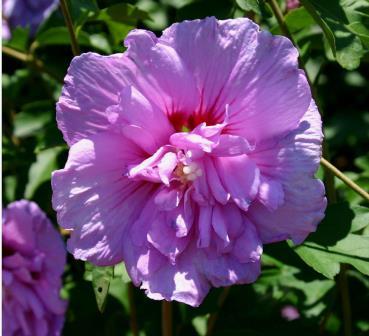 Hibiscus syriacus 'Lavender Chiffon' Picture courtesy MalanseunsCondensed Version:
Hibiscus syriacus 'Lavender Chiffon' Picture courtesy MalanseunsCondensed Version:
This beautiful flowering shrub has been used as a garden shrub in China for generations. It will attract butterflies to your garden and brings a bit of tropical beauty to colder gardens; as well as welcome colour in late summer and autumn, when many summer blooming plants are past their best. Its upright growth habit makes it a good accent plant for the garden. It also makes an excellent screening plant and looks good in groupings and mass plantings. Although it is naturally a multi-stemmed shrub, Rose of Sharon can be trained to have a single trunk and is available as a standard plant, making it an excellent tree for even tiny gardens. It has an upright growth habit with open, loose branches and dark green leaves; which turn yellow in autumn before dropping. The masses of showy flowers are available in single, semi-double and double forms; and come in shades of purple, violet, blue, pink, red and white, often with a spot of a different colour in the middle of the throat.
If you live in a cold frosty area and cannot plant the Hibiscus rosa-sinensis, try planting the Rose of Sharon instead - it prefers cold, frosty winters and hot summers, tolerating temperatures well below zero with no problem. This plant grows well throughout South Africa, but does not like high humidity. Although it can withstand dry conditions, it responds well to regular watering during the growing season; and in the winter rainfall regions it will require regular watering in summer. It flowers best in full sun but will tolerate light shade. This plant loses its leaves in winter and is one of the last deciduous garden plants to shoot new leaves in spring. It is able to tolerate a wide variety of soils, but does best if planted in rich, well-drained soil. The plant does not have invasive roots and grows fairly slowly, with varieties varying in height from +-2 to 4m tall with a spread of +-1.5m; but some varieties can eventually reach +-5m tall and 3m wide. Regular pruning will keep the plant more compact and should be done in winter or early spring. Cutting away some of last season's growth will also help to produce bigger blooms.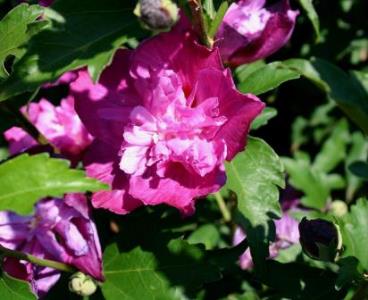 Hibiscus syriacus 'Rosalind' Picture courtesy MalanseunsFull Version:
Hibiscus syriacus 'Rosalind' Picture courtesy MalanseunsFull Version:
Description, History & Interesting Facts:
This beautiful flowering shrub belongs to the same family as mallows and hollyhocks, and is native to China and much of Asia. It is not native to Syria, as Linnaeus thought when he named it H. syriacus. It has been used as a garden shrub in China for generations, where the edible flowers were eaten and the leaves were brewed for a tisane (an herbal infusion drunk for its medicinal effect). This deciduous shrub has an upright growth habit with open, loose branches and dark green leaves; which turn yellow in autumn before dropping. In late summer and autumn, it produces masses of showy flowers; varieties include single, semi-double and double blooms; and come in shades of purple, violet, blue, pink, red and white, often with a spot of a different colour in the middle of the throat. The individual flowers last only for one day, but numerous flower buds are produced on the shrub's new growth, providing prolific flowering over a long period. The foliage of cut shoots will stay green for a long time, making them great to use as fillers in flower arrangements. Once cut, a few new flowers may open from the more mature flower buds.
'Lavender Chiffon' has double lavender flowers with red centres.
'Blue Satin' has large blue flowers.
'Bluebird' has delicate lilac purple flowers.
'White Chiffon' has large, double, white flowers.
'Jean de Arc' has double, white flowers.
'Sugar Tip' has green leaves with creamy margins and double soft-pink blooms.
 Hibiscus syriacus 'White Chiffon' Picture courtesy MalanseunsIn the Garden:
Hibiscus syriacus 'White Chiffon' Picture courtesy MalanseunsIn the Garden:
The Rose of Sharon will attract butterflies to your garden and brings a bit of tropical beauty to colder gardens; as well as welcome colour in late summer and autumn, when many summer blooming plants are past their best. Its upright growth habit makes it a good accent plant for the garden. It also makes an excellent screening plant and looks good in groupings and mass plantings. Although it is naturally a multi-stemmed shrub, Rose of Sharon can be trained to have a single trunk and is available as a standard plant, making it an excellent tree for even tiny gardens. It can also be trained as an espalier or shaped into a hedge. This hibiscus is highly tolerant of urban pollution and looks wonderful if planted alongside other deciduous spring flowering shrubs of a similar height, like Weigela and Philadelphus. Planting it together with other shrubs like Buddleia, which also flowers in high summer, will help to extend the flowering season, and mask the fact that this hibiscus is so slow to come into leaf in spring. In fact, any silver-leafed shrub will make a good foil for the flowers.
 Hibiscus syriacus 'Red Heart' Picture courtesy MalnseunsCultivation:
Hibiscus syriacus 'Red Heart' Picture courtesy MalnseunsCultivation:
If you live in a cold frosty area and cannot plant the Hibiscus rosa-sinensis, try planting the Rose of Sharon instead - it prefers cold, frosty winters and hot summers, tolerating temperatures well below zero with no problem. This plant grows well throughout South Africa, but does not like high humidity. Although it can withstand dry conditions, it responds well to regular watering during the growing season; and in the winter rainfall regions it will require regular watering in summer. It flowers best in full sun but will tolerate light shade. This plant loses its leaves in winter and is one of the last deciduous garden plants to shoot new leaves in spring. It is able to tolerate a wide variety of soils, but does best if planted in rich, well-drained soil. The plant does not have invasive roots and grows fairly slowly, with varieties varying in height from +-2 to 4m tall with a spread of +-1.5m; but some varieties can eventually reach +-5m tall and 3m wide. Regular pruning will keep the plant more compact and should be done in winter or early spring. Cutting away some of last season's growth will also help to produce bigger blooms.
Propagation:
Propagation is best from softwood or semi-hardwood cuttings taken in summer, or by seed.
![]() Pests & Diseases:
Pests & Diseases:
This plant is generally pest and disease free but unfortunately, Japanese beetles love the rose of sharon shrub, and it can also be attacked by aphids and spider mites. Diseases include powdery mildews, leaf spot, blight, and cankers. The buds may drop if the plant is watered too much or too little, or if too much fertiliser is applied.
Warning:
Old varieties of Rose of Sharon can become very invasive under optimal conditions, because the fruit capsule contains numerous seeds which germinate easily, so it is best to prune them off. Newer cultivars are genetic hybrids and produce few (if any) seed capsules.
Toxicity:
Although hibiscus flowers are generally considered safe for humans to eat; some types of hibiscus are toxic to dogs while others are not. Hibiscus syriacus flowers and leaves are considered toxic to dogs, cats and horses if ingested, but its toxic principles are unknown. Animals may show signs of drooling, vomiting, diarrhoea, nausea, anorexia and a lack of appetite; so if a pet has ingested this hibiscus, contact your local veterinarian.
Moonflower - Brugmansia
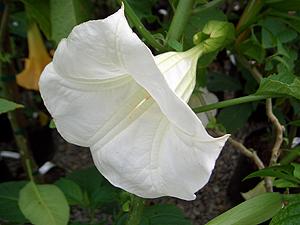 Brugmansia 'White'Condensed Version:
Brugmansia 'White'Condensed Version:
This plant is a breath-taking sight in summer when in full bloom and the entire plant is weighed down with large, drooping, trumpet-shaped flowers up to 30cm long. The flowers are beautifully scented at night and range in colour from pink, to yellow, white, orange and purple. Double flowering cultivars are also available. In warm climates they can bloom year-round and in cooler climates will begin to flower in mid to late spring, continuing into autumn. The large evergreen leaves have prominent wavy margins and remain attractive year-round in warm climates. The moonflower grows quickly and varies in height; in warm regions it will grow bigger than in cold regions. In the first 10 years it can reach +-3m tall with a 2m spread, but with maturity can reach 5m with a 3m spread.
These long-lived woody trees or bushes remain popular garden subjects in frost-free gardens around the world and can be trained to grow as a beautiful small tree or large shrub. Try planting them near a gazebo, patio, or window where their scented flowers can be admired. They will also add drama to the mixed shrub border and are ideal background plants for around the pool or patio. In cold regions they can be planted in large pots which can be moved in winter.
This evergreen takes heat and humidity growing best in warm, moist, frost-free regions. It is a good coastal plant if protected from strong winds. In hot, dry summer rainfall regions and in the winter rainfall regions it will need regular watering in summer. It is semi-hardy to moderate frost if planted in a warm, protected position in the garden; but is not suited to areas which experience severe frost, nor those extremely hot and dry regions. The moonflower requires sun to bloom well but does best in full morning sun and afternoon shade; especially in extremely hot regions. In cooler regions it can take full sun. This plant tolerates most soils but grows best in moist, fertile, well-drained soil. Protect it from strong wind and water regularly during dry spells. The moonflower needs to be mulched and fertilised regularly during the growing season.
 Brugmansia 'Yellow'Full Version:
Brugmansia 'Yellow'Full Version:
Description, History & Interesting Facts:
Brugmansia is a family of plants that is native to the subtropical regions of South America; from Colombia to northern Chile, and south eastern Brazil. They are also known as Angel's Trumpets, sharing that name with the closely related genus Datura. This plant is a breath-taking sight in summer when in full bloom and the entire plant is weighed down with large, drooping, trumpet-shaped flowers up to 30cm long. The flowers are beautifully scented at night and range in colour from pink, to yellow, white, orange and purple. Double flowering cultivars are also available. In warm climates they can bloom year-round and in cooler climates will begin to flower in mid to late spring, continuing into autumn. The large evergreen leaves have prominent wavy margins and remain attractive year-round in warm climates. The moonflower grows quickly and varies in height; in warm regions it will grow bigger than in cold regions. In the first 10 years it can reach +-3m tall with a 2m spread, but with maturity can reach 5m with a 3m spread.
(Brugmansia x candida) has large pure white single blooms with a very strong fragrance at night.
(Brugmansia x candida ‘Plena’) is a double white form.
(Brugmansia suaveolens) has several colour variations including white, yellow, purple, orange and salmon pink.
 Brugmansia 'Pink'In the Garden:
Brugmansia 'Pink'In the Garden:
These long-lived woody trees or bushes remain popular garden subjects in frost-free gardens around the world and can be trained to grow as a beautiful small tree or large shrub. Try planting them near a gazebo, patio, or window where their scented flowers can be admired. They will also add drama to the mixed shrub border and are ideal background plants for around the pool or patio. In cold regions they can be planted in large pots which can be moved in winter.
Cultivation and Harvesting:
This evergreen takes heat and humidity; growing best in warm, moist, frost-free regions. It is a good coastal plant if protected from strong winds; growing well in East London and Kwa-Zulu Natal. In hot, dry summer rainfall regions and in the winter rainfall regions it will need regular watering in summer. The moonflower is semi-hardy to moderate frost if planted in a warm, protected position in the garden; and if it does get cut back by frost it can be pruned back in late spring or early summer and should shoot again. It is not suited to areas which experience severe frost, nor those extremely hot and dry regions. The moonflower requires sun to bloom well but does best in full morning sun and afternoon shade; especially in extremely hot regions. In cooler regions it can take full sun. This plant tolerates most soils, including clay, loam, sand and chalk; but grows best in moist, fertile, well-drained soil. Protect it from strong wind and water regularly during dry spells. Because the moonflower grows so quickly and blooms for months it is a heavy feeder and needs to be mulched and fertilised regularly during the growing season with a balanced feeder. Prune back regularly after blooming to keep neat. Old woody plants can be pruned back hard in spring.
Propagation:
Most Brugmansias may be propagated easily by rooting 10–20 cm cuttings, taken from the end of a branch during the summer; or from hardwood cuttings, taken in autumn.
 Brugmansia 'Orange'Pests & Diseases:
Brugmansia 'Orange'Pests & Diseases:
Moonflowers are susceptible to caterpillars, spider mites, aphids, whiteflies, mealy bugs and beetles. Their large leaves can be sensitive to some sprays, so before spraying the entire plant, it is wise to spray a couple of leaves first and wait a day or two to make sure the spray will not do damage to the plants. Possible diseases include tobacco mosaic, tomato spotted wilt, fusarium wilt, verticillium wilt, Phytophthora, Phoma, and Botrytis.
Toxicity:
All parts of Brugmansia are highly toxic and may be fatal if ingested by humans or animals, including livestock and pets. The plants contain the tropane alkaloids scopolamine and atropine, and are sometimes ingested for recreational or shamanic intoxication among the many Indigenous peoples of western Amazonia; such as the Jivaroan speaking peoples. Likewise, it is a central component in the cosmology and shamanic practices of the Urarina peoples of Loreto, Peru. The potency of the toxic compounds in the plant is variable; the degree of intoxication is unpredictable and can be fatal.
Purple Wreath, Sandpaper Vine - Petrea volubilis
Cross-berry, Kruisbessie, Mokukutu, Mogwane, iLalanyathi, Mulembu, umNqabaza - Grewia occidentalis
 Grewia FlowersDescription, History & Interesting Facts:
Grewia FlowersDescription, History & Interesting Facts:
This attractive branching, woody shrub or small tree is widely spread and can be found growing in all the provinces. It grows in a variety of habitats; from the arid Karroo to coastal dune bush, as well as in evergreen high altitude forests and wooded grasslands.
It makes a most decorative garden subject and is grown for its starry, mauve or pink flowers in summer. The flowers are followed in late summer by distinctive four-lobed, square-shaped berries that turn a shiny reddish-brown to light purple when ripe, and may remain on the tree for long periods.
This plant varies greatly in height and spread, according to the climate of the region in which it is grown. It can reach anything from 2 to 6m tall and is normally well-branched.
Uses:
The pounded bark was used as a shampoo and in traditional medicine the bark is soaked in water to treat wounds. Other parts of the plant were used to treat impotence and infertility, and the roots were believed to help in childbirth.
In the Garden:
This scrambling shrub does not have an aggressive root system, making it perfect to plant near paving, and buildings. It also grows easily in containers but needs to be pruned after flowering to keep it neat.
It is beautiful in the mixed shrub border and makes a good informal hedging or screening plant.
It is essential in every bird and butterfly garden; attracting fruit eating birds like bulbuls, barbets, louries and mousebirds, and the larvae of the rufous-winged elfin butterfly (Eagris nottoana) and buff-tipped skipper (Netrobalane canopus) feed on the leaves.
The shiny, dark green leaves are also browsed by game and livestock.
The fruit is edible and is relished by humans. In certain areas the ripe fruit is collected to brew beer, or to dry for later use.
Cultivation/Propagation:
The Cross-berry grows beautifully in warm, moist, temperate to subtropical regions, but is both frost and drought hardy. It is evergreen but may lose leaves in winter, in certain areas. In very cold regions it is best to plant it in a protected position in the garden and to cover it in winter, until it is established.
For best results in the garden, plant it in good well composted soil and water regularly. It loves to grow in full sun, but can be planted in semi-shade, and in hot inland gardens it will appreciate some shade during the day.
Fertilise it three times a year with a feeder for acid loving plants, and use an iron supplement if the leaves become yellow.
It can be cut back hard if it becomes too large.
Propagate from seeds or semi hardwood cuttings.
Revolution Gold, Black Tea Tree, River Tea Tree - Melaleuca bracteata
 Melaleuca 'JHB Gold' Bushy specimen grown as a shrubDescription, History & Interesting Facts:
Melaleuca 'JHB Gold' Bushy specimen grown as a shrubDescription, History & Interesting Facts:
Melaleuca bracteata is a member of the Myrtle family and endemic to Australia, where it is one of the most widely distributed Melaleuca species. Its main distribution is in eastern Australia from New South Wales to Queensland but it is also found inland and in South Australia, Western Australia and the Northern Territory. It occurs mainly from 50 to 550m above sea level and is found in rugged to undulating and moderately hilly country, in the under-storey of eucalypts open-forest or woodland, and is often the dominant species in thickets or narrow belts among other vegetation types. It is frequently found growing along watercourses and around waterholes, especially in arid areas; along water courses it often dominates the stream-side vegetation. The soils are rather heavy clays and fine alluvials and have a wide range of fertility. It tolerates sites with high pH and salinity.
Melaleuca bracteata is a variable species, some populations are rounded shrubs about two metres high, whilst others develop into trees about 15 metres tall. In the garden the plant is generally pruned to keep small and neat and garden centres generally sell the plants as small trees or large shrubs; +-2 to 6m tall and +-1.5 to 2.5m wide.
Small needle-like leaves with sharp little points are scattered along the branches; 'Revolution Green' has green leaves and 'Revolution Gold' has wonderful golden-yellow to lime-green foliage. In late winter, spring or summer fluffy creamy-white flowers are carried in clusters, on or near the ends of the branches; and if the plant is thriving where it is planted the show of flowers can be quite spectacular.
In the Garden:
These versatile plants are very low maintenance and can be pruned into lovely dense shrubs or small trees; making them ideal as informal screening plants and windbreaks.
They are also invaluable for adding contrast and texture to garden borders and beds; and essential in Mediterranean and dry climate gardens, blending easily with other Mediterranean and coniferous plants such as Cypress and Juniper. T
hey make great bonsai specimens, and the foliage lasts well in a vase, making them excellent fillers for flower arrangements.
Uses:
The wood is close-grained, heavy, hard and durable and could be useful for posts and poles.
The leaves contain essential oils but they are not yet used commercially; Melaleuca alternifolia is the main sourced of tea tree oil.
Cultivation/Propagation:
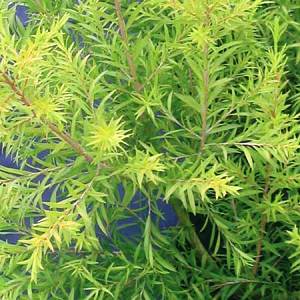 Melaleuca bracteata 'Gold' Picture courtesy steyns-nursery.co.zaRevolution gold and green are virtually pest and disease free and adaptable to most environments, growing well throughout most regions of South Africa.
Melaleuca bracteata 'Gold' Picture courtesy steyns-nursery.co.zaRevolution gold and green are virtually pest and disease free and adaptable to most environments, growing well throughout most regions of South Africa.
They will grow in humid regions and in sandy soils near the coast; and although they tolerate reasonably salty winds, they will look at their best if planted in a more protected position.
They will also tolerate temperatures as low as -7°C once established, but in very cold regions they will need to be sited in a protected spot and covered every winter until the plants are well established. If the top foliage does get burnt by frost it can be pruned away in spring or early summer.
These plants will also tolerate drought and extremely high temperatures up to the mid 30's and low 40 degrees C. For the best results in the garden water moderately during long dry spells.
The plants thrive in full sun but can take some shade; revolution gold will take on a greener hue if grown in too much shade.
Melaleuca is adaptable to most soil conditions - moist or dry, and will grow in sandy or heavy and clay soils, as long as they drain well. If your soil is less than ideal, incorporate lots of compost into the planting holes and apply a mulch of compost around the roots in summer to conserve moisture.
Like many other plants from Australia, melaleuca dislike excessive fertiliser and can be particularly sensitive to phosphorous at high levels. It is therefore best to feed organically with compost and not to use chemical fertilisers at all.
Propagation is from seeds or cuttings taken in spring or autumn, from semi-ripe lateral shoots with a heel. Seed remains viable for a long time and is sown on the surface of a well-drained medium in spring.
Tibouchina, Glory Tree, Glory Bush, Princess Flower - Tibouchina species
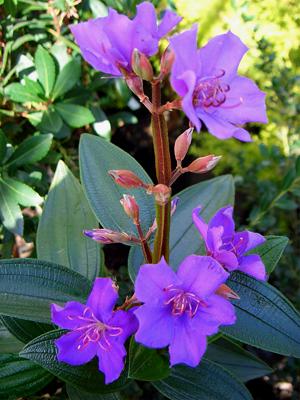 Tibouchina granulosaDescription, History & Interesting Facts:
Tibouchina granulosaDescription, History & Interesting Facts:
Tibouchina is a genus of about 350 species of neo-tropical plants. Neo-tropical plants come from the biogeographic region of the New World that stretches southward from the Tropic of Cancer and includes southern Mexico, Central and South America, and the West Indies. Tibouchinas are native to the rainforests of Mexico, the Caribbean, South America, and especially Brazil.
They are trees, shrubs or subshrubs, varying in height from 0.5 to 25m tall, and are known as glory bushes or glory trees. Terminal panicles of flower buds are held above the foliage, opening to large velvety blooms which fade with age; creating a wonderful two-tone effect.
Flowering usually occurs during the warmer months, but is especially prolific in spring, late summer and autumn. In warm tropical and subtropical gardens this sumptuous display can continue through summer and well into winter. The flowers are particularly attractive to bees and butterflies and last well in a vase.
(Tibouchina granulosa) is a small evergreen tree or large shrub with large velvety, rich purple blooms, fading to a soft mauve with age; and somewhat shiny leaves. The species name 'granulosa' refers to the grainy, gritty texture of the leaves. It can be pruned into a lovely small tree +-3 to 5m tall and +-1.5 to 2m wide.
(Tibouchina granulosa 'Rosea') is very similar to Tibouchina granulosa but produces its large, clear pink flowers several weeks earlier; and is somewhat less vigorous, growing +-3 to 4m tall and +-1 to 1.5m wide.
(Tibouchina urvilleana) is a small evergreen tree or large shrub, which if left un-pruned has an ultimate height of +-4.5m, with a 3m spread, but in the garden it is generally kept a lot smaller, +-3m. It is hardier too cold than other varieties, tolerating light to moderate frost if it is planted in a very warm, protected part of the garden and is covered and the roots thickly mulched in winter. The large vibrant purple blossoms 'bleed' to red in the centre, and the attractive dark green, softly hairy leaves are often edged in red.
(Tibouchina elegans) has rich green, slightly hairy leaves and large purple flowers; growing +- 1.5 to 2.5m tall.
(Tibouchina grandifolia) has large, velvety leaves and is a wide- spreading bush up to 3m, with a height of +-1.5m. It produces large purple-violet flowers with a white centre and will tolerate light frost.
(Tibouchina semidecandra) is a fast growing semi-evergreen +-2.5m tall with dark green velvety leaves and royal purple flowers.
(Tibouchina 'Jules') is a dwarf variety growing +-1m tall and +-1.2m wide. It has small velvet green leaves, and purple flowers, and grows quite happily in large tubs or in garden beds. It is the most sensitive of the Tibouchinas to cold and frost.
In the Garden:
Their large bright saucer-shaped flowers with conspicuous stamens, and their attractive prominently veined leaves,  Mature Tibouchina. Picture courtesy Michele Roelofsenmake them glorious additions to tropical and subtropical gardens and parks.
Mature Tibouchina. Picture courtesy Michele Roelofsenmake them glorious additions to tropical and subtropical gardens and parks.
Because the blooms are carried on terminal panicles, the plants look stunning if viewed from above.
Plant them near a deck or patio as specimen or screening plants, or train them as standard plants for use in containers or above-ground planters. They are wonderful in the mixed shrub border, and if planted in small groupings the impact of bloom-time will be compounded.
The large velvety flowers and often gritty or hairy leaves of these plants make them valuable additions to sensory gardens.
Larger growing species like Tibouchina granulosa can be shaped into lovely small trees, with some early pruning providing strong, upright trunks. The canopy will also need to be pruned regularly to keep the lower branches from drooping to the ground.
Tibouchinas do not have aggressive roots and can be planted fairly close to foundations, but allow them space to spread.
Cultivation/Propagation:

These plants are brittle and prone to breaking in the wind, so plant them in a sheltered position in the garden. They do however have a remarkable ability to re-grow from ground level after being snapped off, and consequently respond well to hard pruning.Their growth habit tends to become somewhat leggy if the plants are not frequently trimmed to keep them bushy; and because they bloom on new growth, trimming immediately after flowering will encourage more new growth and consequently more flowers.
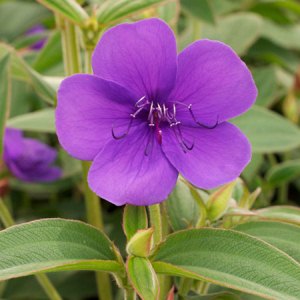 Tibouchina urvilleana Picture courtesy TuberfloraTibouchinas love full sun, but too much harsh sunlight can also be a problem; so if you live in a very hot or dry region plant them in a sunny location which is semi-shaded during the hottest part of the day.
Tibouchina urvilleana Picture courtesy TuberfloraTibouchinas love full sun, but too much harsh sunlight can also be a problem; so if you live in a very hot or dry region plant them in a sunny location which is semi-shaded during the hottest part of the day.
They prefer slightly acidic soils with a good amount of organic matter and good drainage, but will adapt to most well-drained garden soils; from very acid to slightly alkaline. Tibouchinas will not thrive in soils that are too alkaline and will show signs of burn around the leaf margins and yellowing between the leaf veins. They are adapted to chalk, clay loam, loam, loamy sand, sandy clay loam and sandy loam soils; but if your soil is less than ideal, dig lots of acid compost into the planting hole and mulch the roots often.
Water regularly during dry spells to prevent the plant from drying out, but don't keep the soil saturated or root rot can result. Feed regularly with a balanced organic fertiliser to encourage new bud formation.
Glory bushes can sometimes be difficult to establish, and after planting, they may seem to lack the will to grow for a season or two, but do not despair, once they are fully settled they will suddenly 'take off'.
Propagation is by seed sown at 16°C in spring, or by softwood cuttings taken in late spring and semi-hardwood cuttings in summer, both with bottom heat.
Problems, Pests & Diseases:
Tibouchinas are occasionally attacked by aphids, scale and nematodes; and mushroom root-rot can occur if drainage is bad or the plants are over watered. If there is not sufficient air circulation, leaf spots and spider mites can be problematic.
Caution:
Tibouchinas can become invasive species in tropical and subtropical environments outside of their normal range; and all Tibouchina species are considered noxious weeds in Hawaii.
Hibiscus, Tropical Hibiscus, Chinese Hibiscus, China Rose, Shoe Flower - Hibiscus rosa-sinensis
 'The Path'Condensed Version:
'The Path'Condensed Version:
Tropical hibiscus is a rounded, woody, shrub or small tree with glossy dark green leaves which are toothed. The original varieties are generally red and grow +-4.7m tall; but over 10,000 varieties have been created by hybridizing. Hybrids are available with single flower colours and combinations of colours; ranging from white through yellow and orange to scarlet and shades of pink; with single, ruffled and double sets of petals. While hibiscus can bloom abundantly, each flower only lasts for a day or two. Hybrids vary in height, depending on the cultivar; dwarfs are less than 1.5m tall, medium-sized varieties grow between 2 and 3m tall, and tall varieties grow 3 to 5m or more.
 'Lady in Red'With so many forms and variations in growth habit, Hibiscus are the most colourful and versatile shrubs for frost-free zones; and widely grown as an ornamental plant throughout the tropics and subtropics. Because they bloom practically year-round in warm climates, they give a tropical feel to any outdoor living area or pool-side garden; are beautiful specimen plants, and also make a very attractive informal hedges or screens; as long as they can be clipped with hand pruners, and the tips of developing branches are ‘nipped’ in spring and mid-summer to encourage the plants to bush. Since plants flower on new growth, this type of pruning will increase flower production; but untimely pruning often removes flower buds. Hibiscus is also a good cover for bare walls and spaces between windows; and most charming when trained into a patio tree. Hybrids are exceptional pot plants for large pots; and in colder regions the pot can be re-located to a more protected spot, like a greenhouse, sunroom, or any brightly-lit living area in winter. Because they vary so much in growth form, it is vital to choose the correct hibiscus type for the specific purpose you intend using it for.
'Lady in Red'With so many forms and variations in growth habit, Hibiscus are the most colourful and versatile shrubs for frost-free zones; and widely grown as an ornamental plant throughout the tropics and subtropics. Because they bloom practically year-round in warm climates, they give a tropical feel to any outdoor living area or pool-side garden; are beautiful specimen plants, and also make a very attractive informal hedges or screens; as long as they can be clipped with hand pruners, and the tips of developing branches are ‘nipped’ in spring and mid-summer to encourage the plants to bush. Since plants flower on new growth, this type of pruning will increase flower production; but untimely pruning often removes flower buds. Hibiscus is also a good cover for bare walls and spaces between windows; and most charming when trained into a patio tree. Hybrids are exceptional pot plants for large pots; and in colder regions the pot can be re-located to a more protected spot, like a greenhouse, sunroom, or any brightly-lit living area in winter. Because they vary so much in growth form, it is vital to choose the correct hibiscus type for the specific purpose you intend using it for.
 'Gwen Mary'Hibiscus grows best in the warm, moist, humid, frost-free areas of the country which receive good summer rainfall. They also grow well in the winter rainfall regions if they can be watered well in summer. Although they are great coastal plants, they will look at their best if they are sheltered from strong, salt-laden winds. Tropical Hibiscus are not hardy to drought and are tender to frost; but will tolerate light to moderate frost if planted in a warm, protected position in the garden. In cold regions it would also be advisable to cover the plants with a frost protection cover and to mulch the roots in winter.
'Gwen Mary'Hibiscus grows best in the warm, moist, humid, frost-free areas of the country which receive good summer rainfall. They also grow well in the winter rainfall regions if they can be watered well in summer. Although they are great coastal plants, they will look at their best if they are sheltered from strong, salt-laden winds. Tropical Hibiscus are not hardy to drought and are tender to frost; but will tolerate light to moderate frost if planted in a warm, protected position in the garden. In cold regions it would also be advisable to cover the plants with a frost protection cover and to mulch the roots in winter.
Tropical hibiscus prefers a position in a sunny location, which is protected from strong winds. In very hot regions that  'Anna Elizabeth'regularly have temperatures over 30°C, flowering will reduce in full sun, but if sited where they receive a little shade during the heat of the day, the plants will reward you with more frequent and larger blooms. Although they prefer a rich, moist, well-drained soil that is neutral to slightly alkaline; at the coast they do remarkably well in sandy soils, but it is always a good idea to add lots of compost when planting. They will not do well in clay soils that don't drain well, but raised beds will often improve growth and longevity. When planting out, always plant at the same depth as the tree is growing in its nursery bag, as planting too deeply will cause collar rot on the stem and can lead to the eventual death of the plant. Container grown specimens require perfect drainage; do not let water sit in trays under pots.
'Anna Elizabeth'regularly have temperatures over 30°C, flowering will reduce in full sun, but if sited where they receive a little shade during the heat of the day, the plants will reward you with more frequent and larger blooms. Although they prefer a rich, moist, well-drained soil that is neutral to slightly alkaline; at the coast they do remarkably well in sandy soils, but it is always a good idea to add lots of compost when planting. They will not do well in clay soils that don't drain well, but raised beds will often improve growth and longevity. When planting out, always plant at the same depth as the tree is growing in its nursery bag, as planting too deeply will cause collar rot on the stem and can lead to the eventual death of the plant. Container grown specimens require perfect drainage; do not let water sit in trays under pots.
To bloom and grow profusely hibiscus must have sufficient water; they also do not like wet feet, but neither should they be allowed to dry out completely- especially in hot weather. Hibiscus is a heavy feeder, so apply organic fertilisers regularly but lightly throughout summer; watering 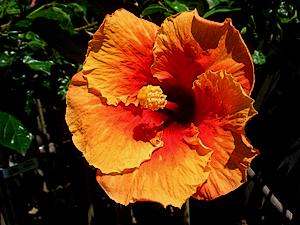 'Bimbo'well before and after fertilising. Try to use fertilisers that include trace elements such as iron, copper, boron, etc. Most growers prefer low phosphate fertilisers like 8:1:5, feeling that it helps produce the most impressive quality and quantity of blooms. Phosphorous can build up in the soil over time and cause a general decline in the health of tropical hibiscus plants. Over-use of high nitrogen fertilisers may encourage leaf growth rather than flower production. Water soluble fertilisers are good both for spraying leaves (foliar feeding) and for fertilising potted plants. Container-grown plants will require more frequent applications of fertiliser and very regular watering. In order to keep your plants neat and full of lush new growth, and top quality blooms, prune out one-third of the old wood in September.
'Bimbo'well before and after fertilising. Try to use fertilisers that include trace elements such as iron, copper, boron, etc. Most growers prefer low phosphate fertilisers like 8:1:5, feeling that it helps produce the most impressive quality and quantity of blooms. Phosphorous can build up in the soil over time and cause a general decline in the health of tropical hibiscus plants. Over-use of high nitrogen fertilisers may encourage leaf growth rather than flower production. Water soluble fertilisers are good both for spraying leaves (foliar feeding) and for fertilising potted plants. Container-grown plants will require more frequent applications of fertiliser and very regular watering. In order to keep your plants neat and full of lush new growth, and top quality blooms, prune out one-third of the old wood in September.
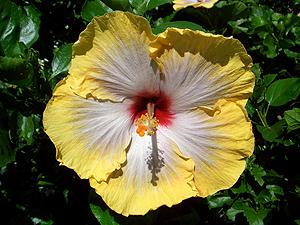 'Fifth Dimension'Full Version:
'Fifth Dimension'Full Version:
Description, History & Interesting Facts:
The genus Hibiscus consists of over 200 species of trees, shrubs, annuals and perennials; and is widely distributed throughout temperate, subtropical and tropical regions of the world. Originally thought to originate in eastern Asia, Tropical Hibiscus spread so widely around the world that exact original locations of the various species are difficult to pin down. The tropical hibiscus belongs to the Malvaceae or Mallow family. Other well-known relatives are the frost hardy Hibiscus Rose-of-Sharon (Hibiscus syriacus); Okra; Cotton and Hollyhocks, to name a few.
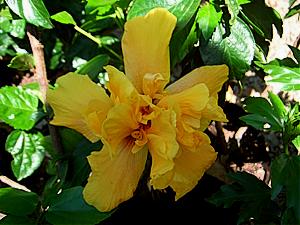 'Crown of Bohemia'Tropical hibiscus is a rounded, woody, shrub or small tree with lance-shaped, glossy dark green leaves with toothed margins. The original varieties are generally red and grow +-4.7m tall, and in the subtropical and temperate Americas, hummingbirds and butterflies are attracted to them on a regular basis. Over 10,000 varieties have been created by hybridizing, many of those by amateur garden hobbyists. Hybrids are available with single flower colours and combinations of colours; ranging from white through yellow and orange to scarlet and shades of pink; with single, ruffled and double sets of petals. While hibiscus can bloom abundantly, each flower only lasts for a day or two. Hybrids vary in height, depending on the cultivar; dwarfs are less than 1.5m tall, medium-sized varieties grow between 2 and 3m tall, and tall varieties grow 3 to 5m or more. Most hybrids have little or no scent, and may produce little nectar, so are generally less attractive to birds.
'Crown of Bohemia'Tropical hibiscus is a rounded, woody, shrub or small tree with lance-shaped, glossy dark green leaves with toothed margins. The original varieties are generally red and grow +-4.7m tall, and in the subtropical and temperate Americas, hummingbirds and butterflies are attracted to them on a regular basis. Over 10,000 varieties have been created by hybridizing, many of those by amateur garden hobbyists. Hybrids are available with single flower colours and combinations of colours; ranging from white through yellow and orange to scarlet and shades of pink; with single, ruffled and double sets of petals. While hibiscus can bloom abundantly, each flower only lasts for a day or two. Hybrids vary in height, depending on the cultivar; dwarfs are less than 1.5m tall, medium-sized varieties grow between 2 and 3m tall, and tall varieties grow 3 to 5m or more. Most hybrids have little or no scent, and may produce little nectar, so are generally less attractive to birds.
Hibiscus 'Agnes Galt' grows upright and has large single, rosy-pink flowers with a crepe paper texture. The slightly ruffled petals become a vibrant red or red-pink at their bases.
Hibiscus 'All Aglow' has large single flowers with bright orange and golden petals with silvery-pink centres. It has a compact growth habit.
Hibiscus 'American Beauty' has large single, striking pink flowers with a dark centre.
Hibiscus 'Bride' has large, very pale pink single flowers which 'bleed' to white in the throat.
Hibiscus 'Brilliant' is a large shrub which is generally 2m tall with an equal spread, but can reach up to 4m tall with maturity, if left un-pruned. It produces masses of single, medium-sized, bright red flowers and is popular for screening and hedging.
Hibiscus 'Canary Island' produces large single pale pink flowers with a very dark pink throat. It is a large shrub, +-3 to 4m tall which is great for screening and hedging.
Hibiscus 'Calafornian Gold' has single flowers, 'bleeding' to pale cream, yellow and red.
Hibiscus 'Conqueror' has light apricot flowers with deep red centres.
Hibiscus 'Cooperi' has small but striking single red flowers and bronze foliage.
Hibiscus 'Debutante' produces single, extra-large, orange-red flowers with white veins and throats.
Hibiscus 'D.J. O'Brian' is a shrub up to 2m tall with double orange flowers and a scarlet centre.
Hibiscus 'Envy' has large single yellow, overlapping flowers.
Hibiscus 'Fiesta' has single overlapping, striking orange flowers centred with maroon shades.
Hibiscus’ Fifth Dimension' has medium-sized creamy coloured blooms, with white to purple-red centres.
Hibiscus ‘Flame Thrower' has large single, fiery orange-yellow blooms.
Hibiscus ‘Foster Brady’ is also called ‘Freddy Brubaker' has single soft apricot blooms with rosy-red centres.
Hibiscus 'Full Moon' has a tall, upright growth habit and produces medium to large, double yellow flowers, with a creamy-white eye.
Hibiscus 'Gwen Mary' has a strong and vigorous growth habit and produces large single watermelon-pink flowers.
Hibiscus 'Halea Kala' produces orange flowers with yellow edged petals.
Hibiscus 'Hawaiian Girl' (also known as Grace Goo) has a compact growth habit and produces large single yellow flowers with burgundy to pink throats.
Hibiscus 'Kinchen Yellow' is vigorous with lush foliage and produces large single yellow flowers with a white throat.
Hibiscus 'Kona' has double pink, medium-sized, scented flowers.
Hibiscus 'Lemon Queen' has single pale yellow flowers with red blotches in the centre. It blooms prolifically for a very long time.
Hibiscus 'Midnight Mood' has large single golden orange blooms with a maroon centre.
Hibiscus 'Miss Betty' is a large growing shrub +-2 to 3m tall and produces single, striking orange-yellow flowers.
Hibiscus 'Monsoon' has large, single and deeply veined, burnt-orange flowers.
Hibiscus 'Mrs. Fairbrass' produces large double orange flowers with maroon centres.
Hibiscus 'Pink Butterfly' is a large shrub which can grow up to 4m tall and is great for hedging and screening if kept 2 to 3m tall. It produces masses of clear pink, single flowers with striking red veins.
Hibiscus 'Ross Estey' has large single soft silvery rose pink flowers.
Hibiscus ‘Snow Queen’ produces small, single red flowers on low, compact bushes with lovely variegated foliage, which is green with grey and white marbling.
Hibiscus 'Swazi Queen' has large glowing single pink flowers with a maroon coloured throat.
Hibiscus 'The Path' has large, single yellow flowers with orange to yellow edges and a pink throat.
Hibiscus 'White Butterfly' grows tall and erect, with small, single white flowers.
Uses:
 'Kenmere Rhapsody'Hibiscus rosa-sinensis is also known as China rose and shoe flower, because in parts of India it is used to shine shoes, and is also used for the worship of Devi. It is the national flower of Malaysia, and in the Pacific Islands the edible flowers are used to embellish salads. This sweet-sour herb is often used in herbal teas to treat many ailments like, loss of appetite, colds, or as a mild laxative and diuretic. Hibiscus flower preparations are also used for hair care. Historically Hibiscus has been used to treat a multitude of ailments, from earache and toothache to fevers, menstrual irregularity and prostate disorders. Research has proven its in-vitro antibacterial activity and that it acts as an antispasmodic for uterine and intestinal spasms; but there is insufficient data about other effects.
'Kenmere Rhapsody'Hibiscus rosa-sinensis is also known as China rose and shoe flower, because in parts of India it is used to shine shoes, and is also used for the worship of Devi. It is the national flower of Malaysia, and in the Pacific Islands the edible flowers are used to embellish salads. This sweet-sour herb is often used in herbal teas to treat many ailments like, loss of appetite, colds, or as a mild laxative and diuretic. Hibiscus flower preparations are also used for hair care. Historically Hibiscus has been used to treat a multitude of ailments, from earache and toothache to fevers, menstrual irregularity and prostate disorders. Research has proven its in-vitro antibacterial activity and that it acts as an antispasmodic for uterine and intestinal spasms; but there is insufficient data about other effects.
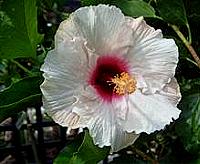 'Madonna'In the Garden:
'Madonna'In the Garden:
With so many forms and variations in growth habit, Hibiscus are the most colourful and versatile shrubs for frost-free zones; and widely grown as an ornamental plant throughout the tropics and subtropics. Because they bloom practically year-round in warm climates, they give a tropical feel to any outdoor living area or pool-side garden; are beautiful specimen plants, and also make a very attractive informal hedges or screens; as long as they can be clipped with hand pruners, and the tips of developing branches are ‘nipped’ in spring and mid-summer to encourage the plants to bush. Since plants flower on new growth, this type of pruning will increase flower production; but untimely pruning often removes flower buds. Hibiscus is also a good cover for bare walls and spaces between windows; and most charming when trained into a patio tree. Hybrids are exceptional pot plants for large pots; and in colder regions the pot can be re-located to a more protected spot, like a greenhouse, sunroom, or any brightly-lit living area in winter. Because they vary so much in growth form, it is vital to choose the correct hibiscus type for the specific purpose you intend using it for.
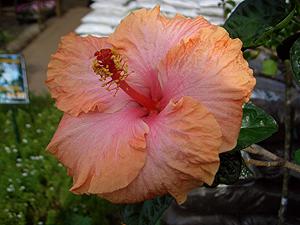 'Ross Estey'Cultivation:
'Ross Estey'Cultivation:
Hibiscus grows best in the warm, moist, humid, frost-free areas of the country which receive good summer rainfall. They also grow well in the winter rainfall regions if they can be watered well in summer. Although they are great coastal plants, they will look at their best if they are sheltered from strong, salt-laden winds. Tropical Hibiscus are not hardy to drought and tender to frost; but will tolerate light to moderate frost if planted in a warm, protected position in the garden. Growing them next to a north, or north-west facing wall will provide a sheltered environment, with the sunshine and warmth absorbed by the wall maintaining a moderate air temperature around established plants; make sure you leave at least 1m of space between the shrub and the wall. In cold regions it would also be advisable to cover the plants with a frost protection cover and to mulch the roots in winter.
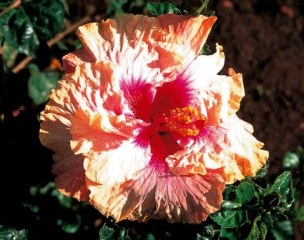 'Freddy Brubaker' Picture courtesy MalanseunsTropical hibiscus prefers a position in a sunny location, which is protected from strong winds. In very hot regions that regularly have temperatures over 30°C, flowering will reduce in full sun, but if sited where they receive a little shade during the heat of the day, the plants will reward you with more frequent and larger blooms. Although they prefer a rich, moist, well-drained soil that is neutral to slightly alkaline; at the coast they do remarkably well in sandy soils, but it is always a good idea to add lots of compost when planting. They will not do well in clay soils that don't drain well, but raised beds will often improve growth and longevity. When planting out, always plant at the same depth as the tree is growing in its nursery bag, as planting too deeply will cause collar rot on the stem and can lead to the eventual death of the plant. Container grown specimens require perfect drainage; do not let water sit in trays under pots. Plants should be spaced with room between them to allow air to circulate, thus reducing pests and diseases.
'Freddy Brubaker' Picture courtesy MalanseunsTropical hibiscus prefers a position in a sunny location, which is protected from strong winds. In very hot regions that regularly have temperatures over 30°C, flowering will reduce in full sun, but if sited where they receive a little shade during the heat of the day, the plants will reward you with more frequent and larger blooms. Although they prefer a rich, moist, well-drained soil that is neutral to slightly alkaline; at the coast they do remarkably well in sandy soils, but it is always a good idea to add lots of compost when planting. They will not do well in clay soils that don't drain well, but raised beds will often improve growth and longevity. When planting out, always plant at the same depth as the tree is growing in its nursery bag, as planting too deeply will cause collar rot on the stem and can lead to the eventual death of the plant. Container grown specimens require perfect drainage; do not let water sit in trays under pots. Plants should be spaced with room between them to allow air to circulate, thus reducing pests and diseases.
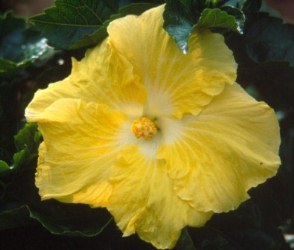 'Kinchen Girl' Picture courtesy MalanseunsTo bloom and grow profusely hibiscus must have sufficient water; they do not like wet feet, but neither should they be allowed to dry out completely - especially in hot weather. Drip irrigation is great for hibiscus, as it is easy to regulate, and also avoids getting water droplets onto the delicate flower petals. Mulch the roots to keep them cool and to preserve water, but do not let the mulch touch the stem. Hibiscus is a heavy feeder, so apply organic fertilisers regularly but lightly throughout summer; watering well before and after fertilising. Try to use fertilisers that include trace elements such as iron, copper, boron, etc. Most growers prefer low phosphate fertilisers like 8:1:5, feeling that it helps produce the most impressive quality and quantity of blooms. Phosphorous can build up in the soil over time and cause a general decline in the health of tropical hibiscus plants. Over-use of high nitrogen fertilisers may encourage leaf growth rather than flower production. Water soluble fertilisers are good both for spraying leaves (foliar feeding) and for fertilising potted plants. Container-grown plants will require more frequent applications of fertiliser and very regular watering. In order to keep your plants neat and full of lush new growth, and top quality blooms, prune out one-third of the old wood in September.
'Kinchen Girl' Picture courtesy MalanseunsTo bloom and grow profusely hibiscus must have sufficient water; they do not like wet feet, but neither should they be allowed to dry out completely - especially in hot weather. Drip irrigation is great for hibiscus, as it is easy to regulate, and also avoids getting water droplets onto the delicate flower petals. Mulch the roots to keep them cool and to preserve water, but do not let the mulch touch the stem. Hibiscus is a heavy feeder, so apply organic fertilisers regularly but lightly throughout summer; watering well before and after fertilising. Try to use fertilisers that include trace elements such as iron, copper, boron, etc. Most growers prefer low phosphate fertilisers like 8:1:5, feeling that it helps produce the most impressive quality and quantity of blooms. Phosphorous can build up in the soil over time and cause a general decline in the health of tropical hibiscus plants. Over-use of high nitrogen fertilisers may encourage leaf growth rather than flower production. Water soluble fertilisers are good both for spraying leaves (foliar feeding) and for fertilising potted plants. Container-grown plants will require more frequent applications of fertiliser and very regular watering. In order to keep your plants neat and full of lush new growth, and top quality blooms, prune out one-third of the old wood in September.
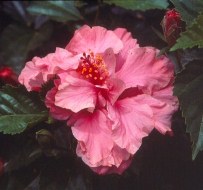 'Kona' Picture courtesy MalanseunsPropagation:
'Kona' Picture courtesy MalanseunsPropagation:
Propagation is by softwood cuttings taken in late spring or semi-ripe cuttings in summer. Hardwood cuttings can also be taken in winter. Some cultivars are difficult to propagate by cuttings and are layered or grafted onto a suitable rootstock in spring.
Pests & Diseases:
The most common pest of Hibiscus is the hibiscus stem borer, a beetle that eats out the soft central core of mature branches, causing the branches to die back. Prune out the infected branches back to healthy growth and use a suitable systemic insecticide regularly to control this pest.
Hibiscus plants are also attacked by caterpillars, hibiscus beetle (holes in flowers), metallic flea beetle (holes in leaves); aphids, red spider, mealybug, scale and whitefly. They are also susceptible to rust, fungal leaf spots, bacterial blight, verticillium wilt, viruses, and stem and root rots; so keep a lookout and spray with an organic insecticide or fungicide if necessary.
Poor lighting, changes in temperature, or irregular watering can cause the buds and flowers to drop; and yellow leaves may be a sign of low nitrogen.
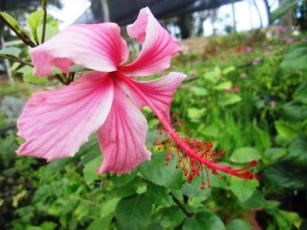 'Pink Butterfly' Picture courtesy www.steyns-nursery.co.zaToxicity:
'Pink Butterfly' Picture courtesy www.steyns-nursery.co.zaToxicity:
Although hibiscus flowers are generally considered safe for humans to eat; some types of hibiscus are toxic to dogs while others are not. While the Rose of Sharon (Hibiscus syriacusis) specifically is considered to be toxic to dogs, cats and horses, other species may cause toxic reactions as well, especially the flowers, although poisoning is usually mild. For safety's sake, keep your hibiscus plants away from pets. Eating plant matter, even nontoxic flowers, can cause gastrointestinal upset, diarrhoea and vomiting if your pet ingests a large amount of it. Prevent issues by monitoring your dog around any plants, especially the hibiscus.
Camellia - Camellia sasanqua
Japanese Sago Palm - Cycas revoluta
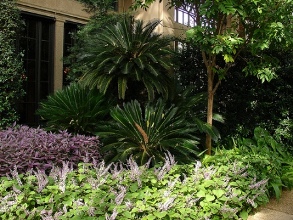 Cycas revoluta. Picture courtesy Karl Gercens. Visit his flickr photostreamDescription, History & Interesting Facts:
Cycas revoluta. Picture courtesy Karl Gercens. Visit his flickr photostreamDescription, History & Interesting Facts:
The durability and indestructibility of Cycas revoluta is legendary. They not only outlived the dinosaurs, but the adverse forces of nature and the oversights of mankind! They are one of the most primitive living seed plants and are related to conifers and Ginko trees. These cone bearing plants are often called "living fossils" because they have changed very little in the last 200 million years, and can be traced back to the ancient flora of the early Mesozoic era. Cycas revoluta is native to southern Japan and is also called the king sago palm, or sago palm; but actually it is a cycad and not a palm at all.
It is very slow growing and this evergreen can reach large proportions with time; but in the garden, give it about 2 to 3m to spread. It is one of the most widely cultivated cycads that is grown for its rugged trunk and symmetrical crown of large, dark green leathery leaves. It develops a bare stem as it ages and old specimens can branch multiple times, producing multiple heads of leaves.
Sago palms produce a periodic "flush" of new leaves, called a "break". These emerge all at once in a circular pattern and are very tender, until they begin to harden several weeks later. Do not disturb or re-pot the plant during this process and do not allow the plant to become excessively dry; otherwise new foliage may wither and die or become yellow and stunted. Eventually, offsets begin to grow at the base of older plants, and occasionally in the crown. The addition of offsets provides a source of new plants and many possibilities for developing a unique specimen.
In the Garden:
Use it in the garden as a bold accent plant and to add a tropical look to your garden. The Japanese Sago Palm is used extensively to complement modern architecture in office parks and homes. It is a favourite subject for Bonsai beginners in Japan and grows beautifully in pots.
Cultivation:
Cycas revoluta is one of the easiest plants to grow and is widely planted in warm temperate and subtropical regions, but is hardy to moderate frost, if the soil is kept on the dry side in winter. It will grow in semi-shade or full sun and requires fertile but very well drained soil.
The Japanese Sago Palm is fairly drought tolerant and prefers to be on the dry side, rather than too wet. If drainage is poor the plant could rot. Water it judiciously during dry spells and plant it slightly above the soil line. Do not plant it in a hole or depression which retains water or is swampy.
Re-potting is best done in winter or early spring, but remember that Cycads prefer to be root bound and should be re-potted into a container only slightly larger than the root system. If roots are trimmed for bonsai use, remove a comparable amount of lower leaves.
A good balanced organic fertiliser can be applied in spring and again in late summer. Too little plant food is far better than too much.
Old leaves turn yellow from over watering or too much fertilizer, and if If new leaves emerge yellow or distorted, then you have probably been over or under fertilizing. Cut them off immediately so that the Cycad will start making a new set of leaves.
Once leaves turn yellow or brown, they should be removed from the plant.
Transplanting or moving Cycads can be successful if a few guidelines are followed. Do this in winter or early spring when they are not actively growing.
First remove all but the uppermost ring of leaves, because you will damage some roots in the transplanting process and the remaining roots will not be able to support them. For large plants, tie the leaves together at the top with some rope, to make moving them easier. Using a shovel, gently crowbar the plant out of the ground and move it immediately to a pre-dug hole that is slightly larger than the root-ball of the plant.
Centre the plant in the hole, ensuring that the soil level is slightly above the old one. Fill in with composted soil and firm the plant into the ground. Large specimens will need to be staked for awhile to keep them from falling over. Water when the soil becomes almost totally dry but never overwater at this stage. If transplanting is successful, new leaves should emerge by summer, but often it can take a year or two before the plant resumes active growth.
Propagation:
Propagation of Cycas revoluta is either by seed or by removal of basal offsets called "pups." Cycads are dioecious, having separate male and female plants. The female produces a huge golden flower which slowly opens when it is fertile, then closes and begins to produce viable seed, if pollination from a male was successful. The male produces a golden cone, shaped like a giant pine cone. When the females flower and the males produce cones, pollination can be done by hand. The timing of pollination can be somewhat critical. The female flower will open when it is ready to receive pollen, and the scales on the male cones will open to reveal pollen and release a sweet odour. At this point, snap or saw off the male cone from the centre of the plant and shake it over the female. A cone has plenty of pollen and can be used on several females at a time, for several days in a row. Mature specimens will flower only every second or third year. Unfortunately there is no way of telling if a young plant is a male or female.
The seeds will slowly develop during the summer until they become the size of a walnut, turning from yellow to bright orange in the winter. They will be ready to be removed the following year. Seeds that are ready to harvest will be easy to pull off the plant. Remove the orange skin by soaking the seeds in a bucket of water for a few days, changing the water every day. Peel off the skin, using gloves to prevent your hands from turning orange. If the skin won't come off t plant it with the skin on. If a seed is tiny or floats when placed in water it is infertile and won't sprout.
Plant sago seeds on their side. To demonstrate this, take a handful, drop them on a soft floor and watch how they fall. They will fall on their sides, just like they would if they fell from the mother plant in the wild. Press the seeds 2/3 of the way into the soil; only the top flat side of the seed should peek out of the soil. Plant the seeds into well drained soil and place the pots in a shaded position outdoors, as the new leaves can scorch in too much sun. Water when the soil becomes dry. You do not want to keep them constantly wet, yet you do not want them to dry out completely either. Germination can take up to 4 months, depending on the time they are sown. Seed can be stored for several months in a cool, dry place. Before planting, soak in a bucket of water for a day to re-moisturize the hard ivory seed coat.
Problems, Pests & Diseases:
Yellow leaves usually indicate incorrect watering or fertilising.
Rotting can occur in soils which do not drain well and if the plant is overwatered.
Watch out for scale insects and mealy bugs, and spray with a mineral oil or organic solution, but be careful to follow the directions on the container. Always water the plant well the day before, and spray during the coolest part of the day.
Warning:
All parts of Cycas revoluta are extremely poisonous to both humans and animals if ingested. Pets are at particular risk since they seem to find the plant very palatable.
Clinical symptoms of ingestion will develop within 12 hours and may include vomiting, diarrhoea, weakness, seizures, liver failure, or hepatotoxicity. Your pet may appear bruised; have nose bleeds or blood in the stool. If any quantity of the plant is ingested, a poison control centre or doctor should be contacted immediately. Effects of ingestion can include permanent internal damage and death.


